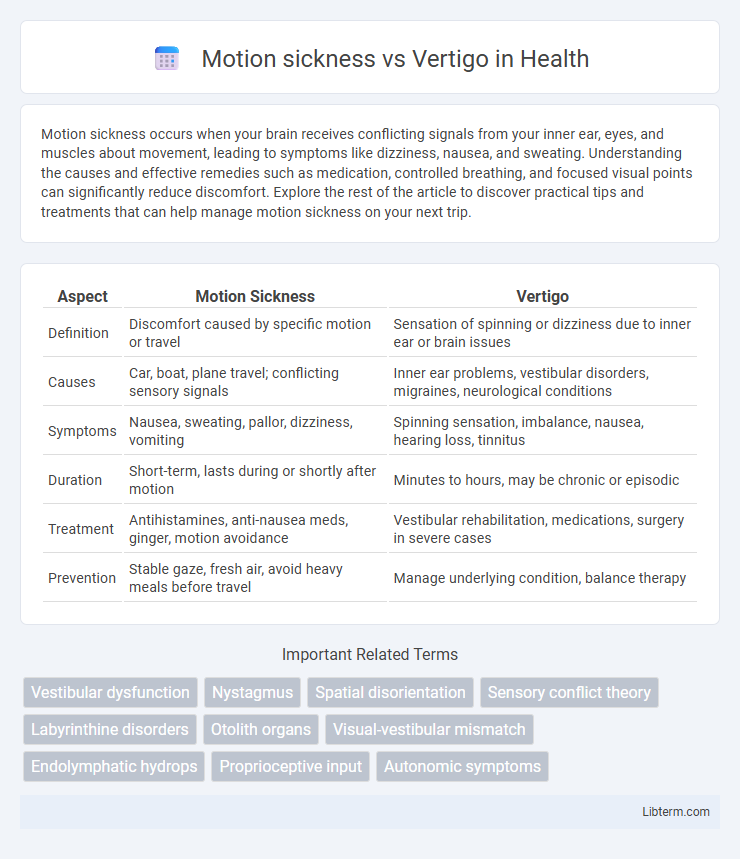Motion sickness occurs when your brain receives conflicting signals from your inner ear, eyes, and muscles about movement, leading to symptoms like dizziness, nausea, and sweating. Understanding the causes and effective remedies such as medication, controlled breathing, and focused visual points can significantly reduce discomfort. Explore the rest of the article to discover practical tips and treatments that can help manage motion sickness on your next trip.
Table of Comparison
| Aspect | Motion Sickness | Vertigo |
|---|---|---|
| Definition | Discomfort caused by specific motion or travel | Sensation of spinning or dizziness due to inner ear or brain issues |
| Causes | Car, boat, plane travel; conflicting sensory signals | Inner ear problems, vestibular disorders, migraines, neurological conditions |
| Symptoms | Nausea, sweating, pallor, dizziness, vomiting | Spinning sensation, imbalance, nausea, hearing loss, tinnitus |
| Duration | Short-term, lasts during or shortly after motion | Minutes to hours, may be chronic or episodic |
| Treatment | Antihistamines, anti-nausea meds, ginger, motion avoidance | Vestibular rehabilitation, medications, surgery in severe cases |
| Prevention | Stable gaze, fresh air, avoid heavy meals before travel | Manage underlying condition, balance therapy |
Understanding Motion Sickness: Causes and Symptoms
Motion sickness occurs when conflicting signals from the inner ear, eyes, and sensory receptors disrupt the brain's ability to maintain balance, often triggered by car, boat, or airplane travel. Symptoms include nausea, dizziness, sweating, and vomiting, which result from the nervous system's response to perceived motion discrepancies. Unlike vertigo, which is typically caused by inner ear disorders affecting balance, motion sickness is primarily a sensory mismatch without underlying vestibular pathology.
What is Vertigo? Key Features and Origins
Vertigo is a sensation of spinning or dizziness caused by dysfunction in the inner ear or brain regions responsible for balance, such as the vestibular system. Key features include a false sense of movement, nausea, imbalance, and sometimes vomiting, often triggered by head position changes. Origins of vertigo typically involve vestibular disorders like benign paroxysmal positional vertigo (BPPV), Meniere's disease, vestibular neuritis, or central nervous system conditions affecting the brainstem or cerebellum.
Motion Sickness vs Vertigo: Key Differences
Motion sickness results from sensory conflict between visual and vestibular inputs during movement, causing nausea, sweating, and dizziness. Vertigo is a neurological condition characterized by a false sensation of spinning or motion, often linked to inner ear disorders like benign paroxysmal positional vertigo (BPPV). Unlike vertigo's spinning sensation, motion sickness primarily involves discomfort triggered by travel or motion exposure, highlighting distinct underlying causes and symptoms.
Common Triggers for Motion Sickness
Common triggers for motion sickness include repetitive or conflicting motion signals such as those experienced during car rides, boat trips, or airplane flights. Sensory mismatch between the inner ear, eyes, and deeper body parts often leads to symptoms like nausea and dizziness. Unlike vertigo, which is primarily caused by inner ear disorders or neurological conditions, motion sickness is specifically induced by environmental movement factors.
Major Causes and Types of Vertigo
Motion sickness arises from sensory conflict between the inner ear, eyes, and brain during movement, commonly triggered by car, boat, or airplane travel. Vertigo, a distinct condition, is primarily caused by inner ear disorders such as benign paroxysmal positional vertigo (BPPV), Meniere's disease, and vestibular neuritis, resulting in a sensation of spinning or dizziness. Understanding the major types of vertigo, including peripheral vertigo linked to vestibular system issues and central vertigo caused by brainstem or cerebellar dysfunction, is crucial for accurate diagnosis and treatment.
How Motion Sickness Feels: Patient Experiences
Motion sickness often manifests as nausea, cold sweats, dizziness, and an overwhelming sense of unease during or after moving experiences such as car rides or boat trips. Patients frequently describe a churning sensation in the stomach accompanied by headaches and excessive salivation, creating discomfort that disrupts concentration and balance. Unlike vertigo, which involves a spinning sensation linked to inner ear disturbances, motion sickness primarily triggers general queasiness without true dizziness.
Recognizing Vertigo: Signs and Sensations
Vertigo is characterized by a distinct sensation of spinning or dizziness, often accompanied by nausea, imbalance, and difficulty focusing the eyes. Unlike motion sickness, which results from sensory conflict during actual movement, vertigo arises from inner ear disorders or neurological conditions affecting the vestibular system. Recognizing vertigo involves identifying symptoms such as a false sensation of motion, sudden onset of dizziness without actual movement, and possible hearing changes or tinnitus.
Diagnostic Methods: Motion Sickness and Vertigo
Diagnostic methods for motion sickness primarily involve patient history and symptom evaluation during or after exposure to motion stimuli, often using motion simulators or standardized questionnaires like the Motion Sickness Susceptibility Questionnaire (MSSQ). In contrast, vertigo diagnosis requires more specialized tests such as the Dix-Hallpike maneuver to identify benign paroxysmal positional vertigo (BPPV), vestibular function tests including videonystagmography (VNG), electronystagmography (ENG), and audiometric assessments to determine inner ear or neurological causes. Advanced imaging techniques like MRI may be utilized in vertigo cases to rule out central nervous system pathologies, which are not typically associated with motion sickness.
Effective Treatments: Managing Motion Sickness vs Vertigo
Effective treatments for motion sickness include antihistamines like dimenhydrinate and meclizine, which reduce nausea and dizziness by blocking vestibular stimulation. Vertigo management often involves vestibular rehabilitation therapy (VRT) to improve balance and habituate the brain to abnormal signals, along with medications such as vestibular suppressants or corticosteroids for underlying causes. Both conditions benefit from lifestyle adjustments like avoiding triggers, staying hydrated, and maintaining steady visual focus to alleviate symptoms.
Prevention Tips for Motion Sickness and Vertigo
Motion sickness prevention includes focusing on stable visual cues, such as looking at the horizon, and minimizing head movement during travel to reduce sensory conflict. For vertigo, exercises like the Epley maneuver help reposition ear crystals, while avoiding sudden head movements and managing stress can lessen episodes. Staying hydrated, getting adequate rest, and avoiding triggering environments benefit both conditions by supporting overall vestibular health.
Motion sickness Infographic

 libterm.com
libterm.com